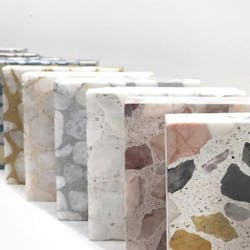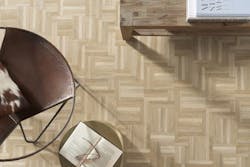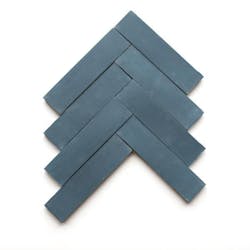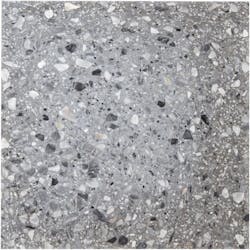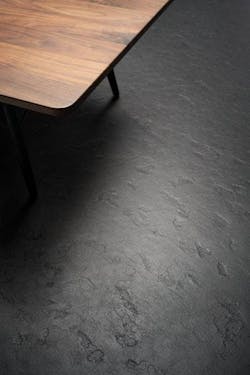5 Stylish Alternatives to Wood and Porcelain Flooring
Hardwood and porcelain tile aren't the only surfaces reaping gains as homeowners continue to migrate toward hardsurface flooring. Resilients, namely luxury vinyl tile (LVT), have been making a play for people’s wallets and lifestyle needs, while fresh takes on old standbys are also broadening design possibilities.
Currently, there are three main categories of LVT. The earliest—now more than a decade old—is a flexible, glue-down product commonly found in commercial applications, notes Jimmy Tuley, vice president of residential resilient business for Mannington Mills. More recently, the industry introduced WPC, a thicker (up to 8 mm) option typically consisting of a wear layer with a finish coat on top, followed by a decorative layer, a foamed rigid PVC core in which air pockets help absorb sound, and, under that, an attached pad for additional sound dampening and comfort underfoot. Depending on whom you ask, “WPC” can stand for wood-plastic or wood-polymer core, despite the absence of wood in the product; more apt is “enhanced polymer core,” Tuley says.
The newer solid polymer core (SPC) vinyl falls between WPC and traditional LVT in thickness and has a similar multilayered construction. Because its rigid core is compressed and more dense, it is highly dent-resistant, stands up to heavy traffic, and remains dimensionally stable in a wide range of temperatures, notes Foster Bishop, Shaw Floors’ resilient category manager for builder and multifamily. You can put it in a three-season porch or an unconditioned cabin in the winter or summer, Tuley explains.
Loft recreates the look of classic parquet in the company’s Adura MaxAPEX WPC luxury vinyl plank, which features a rigid waterproof HydroLoc core. Available in a 16-inch-by-48-inch format in four colors, planks feature a ScratchResist aluminum oxide coating and are FloorScore certified.
PRACTICAL MATTERS IN FLOORING
LVT sales in the last couple of years have grown north of 20 percent, and 40 to 45 percent for WPC and SPC alone, Tuley says. A chief draw for homeowners, he notes, is the 100 percent waterproof guarantee, making LVT ideal for kitchens, baths, mudrooms, and laundry rooms. Installation requires minimal floor prep, which “helps expand the labor pool,” says Scott Baker, vice president of national accounts for single family at Shaw Industries, and LVT’s imperviousness to water means it’s unaffected by challenging onsite conditions, such as high-moisture slabs. Moreover, both WPC and SPC can be floated over an existing hard-surface floor.
Improved digital printing and embossing technology, along with beveled edges and wider, longer planks—some measuring 8 inches by 72 inches—is helping LVT wrest market share from hardwood and wood-effect porcelain tile. As with their real-life counterparts, hardwood depictions are trending toward more natural, understated looks, where interest is generated by “plank-to-plank variation,” says Terry Marchetta , director of residential styling for Mannington. Think white oak, ash, hickory, walnut, and weathered pine. Also popular are herringbone, chevron, and mixed-plank designs.
These encaustic cement tiles offer subtle color variation from tile to tile, creating a wabi-sabi effect, the brand says. Measuring 8 by 2 inches and 5/8-inch thick, tiles come in over 50 colors. (Federal Blue, shown.)
Beyond hardwood, luxury vinyl is taking cues from other materials, some flooring related, others not. Mannington’s latest LVT offerings, for example, mimic encaustics, worn concrete, and a blend of terrazzo and natural wood. Shaw’s Urban Organics collection features slate, white marble, travertine, and concrete visuals, while Parterre Vertu planks include a variety of wood inspirations and a pattern derived from woven baskets.
Linoleum is another resilient product seeing a sales uptick. While its market share is modest, homeowners are rediscovering linoleum’s health and environmental benefi ts, says Tim Donahue, residential division sales manager for Forbo Flooring Systems. Made of linseed oil, wood fl our, and pine rosin, the all-natural material doesn’t off-gas, resists water, is durable, and has antistatic and antimicrobial properties. It also quickly comes to room temperature, dampens sound, and doesn’t require stripping or waxing, unlike some LVT products. Forbo’s branded linoleum, Marmoleum, also comes in a click-and-lock version for glue-free installation.
The product of a partnership with one of Italy’s oldest terrazzo tile makers, the Fragments Terrazzo collection draws inspiration from pieces used in 17th-century Venetian palazzi. It offers 24-inch-square tiles in two colorways: Bardiglio Plumbeo (shown) and Carrara Luminosa.
STONE AND MORE
In the luxury market, however, authentic materials, such as hardwood and natural stone, still dominate. The latter’s elevated aesthetic and range of price points remain compelling selling points, says DeeDee Gundberg , director of product development and design at Ann Sacks . Marble and travertine are still tops, with colors creeping toward darker tones. Limestone with a raked, bushhammered, brushed, or sandblasted finish and straight-cut edges offers an earthy yet modern look, says Jared Becker, vice president of design and marketing at Walker Zanger.
Flooring that serves as more than just a neutral background is also in demand among well-heeled clients. Chuck Wheelock, founder of Old Greenwich, Conn.-based custom kitchen, bath, and cabinetry company Wheelock Design Associates, says clients are requesting classic black-and-white stone checkerboard flooring for kitchens, and Marchetta says elaborate parquet—beyond chevron and herringbone—is going strong. In stone, where floor medallions and other decorative motifs were once strictly custom, some recent collections let designers recreate that look using precut tiles in nonrectilinear shapes, notes Beth Dotolo, co-founder and principal interior designer for Pulp Design Studios, in Dallas and Seattle.
The Marmoleum Solid collection offers five textured floors, including this Slate option embossed to replicate the look of natural stone. Slate is available in fi ve colors and a choice of 2.5 mm or 3.5 mm thicknesses. Durable enough for use in residential or commercial applications, Marmoleum helps dampen sound and has bacteriostatic properties.
As to other flooring options, encaustics are available in increasingly modern graphics, laminates are becoming more water-resistant, and concrete continues to attract fans, especially in California, Florida, and Texas. Sarah Hutchinson , ConcreteNetwork.com’s director of digital content, notes concrete flooring in stained finishes is now also being used in more traditional, rustic homes. Other concrete trends include metallic coatings and colored, textured faux-wood looks.
Terra-cotta seems poised for a comeback. Wheelock has already done a few kitchen fl oors with the material and Walker Zanger will be rolling out an Italian collection of handmade frostproof, espresso-colored terra-cotta tile.
And then there’s terrazzo, which was exhibited at multiple booths at this year’s Kitchen & Bath Industry Show, including Ann Sacks, which showed new additions to its Renato line. Dotolo is excited about the possibilities, especially as glass and stone chips in the latest terrazzo tiles can be customized by color and size. Of course, terrazzo can also be poured to create one-of-a-kind floor designs. “Anything you could imagine using marble for, you could use terrazzo instead,” Dotolo says.
